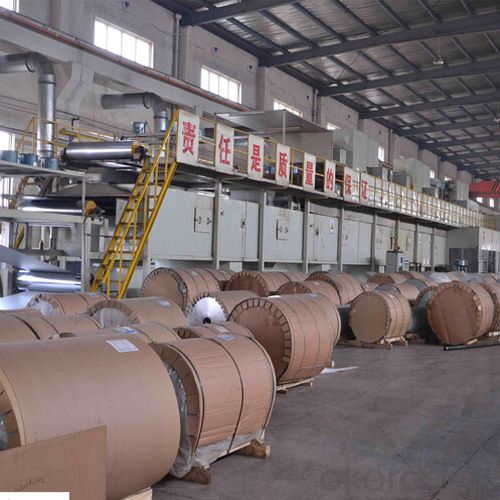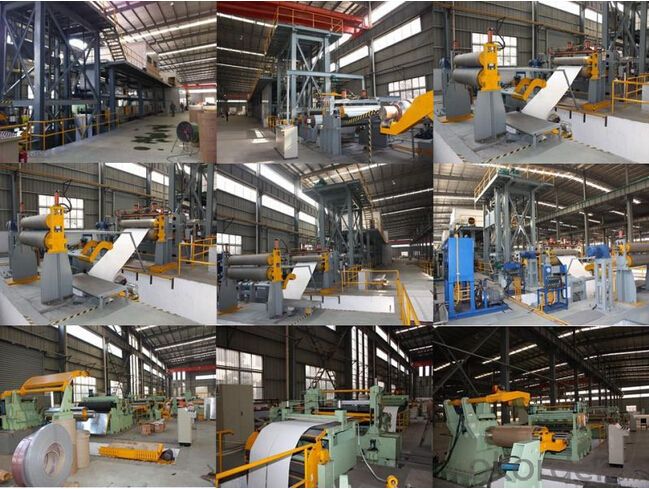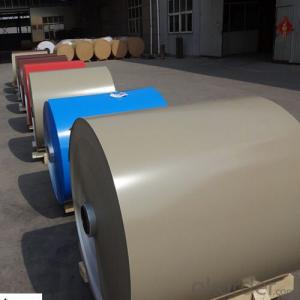Polyester Coated Aluminum Coil for Construction
- Loading Port:
- Shanghai
- Payment Terms:
- TT OR LC
- Min Order Qty:
- 5 m.t
- Supply Capability:
- 10000 m.t/month
OKorder Service Pledge
OKorder Financial Service
You Might Also Like
Item specifice
1.Structure of Polyester Coated Aluminum Coil for Construction Description:
Color coated aluminum coil is aluminum coil after cleaning, coating, and baking. Surface of aluminum coil can be painted to any color. Dong Chuan color-coated aluminum coil and aluminum sheet coils mainly come from Southwest Aluminum, Nanping, Chinalco, Ruimin, etc. which are the best raw materials suppliers domestically. Our coating paints are mainly from American PPG and Swedish Becker.
2.Main Features of Polyester Coated Aluminum Coil for Construction:
Good mechanical properties.
Easy processing, wearability.
Corrosion resistance
Resistance to oxidation.
3. Polyester Coated Aluminum Coil for Construction Images:


4. Polyester Coated Aluminum Coil for Construction Specification:
Item | Color Coated Aluminium coil,Aluminium coil,Aluminium alloy coil, |
Standard | GB/T3190-2008,GB/T3880-2006,ASTM B209,JIS H4000-2006,etc |
Material | 1060,1050,1070,1100,a1100P,3003,3005,5052,5652,5154,5254,5454,5083,5754, 5086,5056,5456,2A12,2024,2014,6061,6062,6063,6082,7003,7004,7075,8010,8020,etc |
Thickness | 0.1-200mm |
Width | 10-2600mm |
Length | 1-12m,or as required |
Temper | 0-H112,T3-T8,T351-T851 |
Surface | mill,bright,polished,hair line,brush,sand blast,checkered,embossed,etching,etc |
5.FAQ
Q1.How long have you been in this product?
A1:More than 10 years.
Q2. What's the minium quantity(MOQ)?
A2. 5 Metric tons
Q3. How long is shipping time?
A3. 7 (ready-made products)-25 days(OEM)
Q4. How do you guarantee the quality?
A4. 1. Cooperating and Exchaning experience with sevral quoted aluminum companies
2. Japanese and Swiss production line and skilled works (regular training and testing)
3. more than 10 years production experience.
Q5. Do you have after sale service?
A5. Yes. Any quality problem occurs within one year, pls take photoes,we will be responsible.
- Q:How does the reflective film stick to the aluminum plate?
- Put the plate clean, dry, reflective film a head from the aluminum back 2CM at the beginning attached to the aluminum plate, wrapping, pull to the front, back and side brush paper hanging tear reflective film side with the hanging brush to the aluminum paste, try to avoid bubbles.
- Q:Can aluminum sheets be laminated with other materials?
- Indeed, it is possible to laminate aluminum sheets with alternative substances. Lamination denotes the fusion of multiple layers of diverse materials, thereby yielding a composite material that possesses heightened qualities. Aluminum sheets can be laminated with a variety of materials, including plastics, fabrics, papers, or other metals, through the utilization of either adhesive bonding or the application of heat and pressure. This process of lamination facilitates the amalgamation of favorable attributes from distinct materials, ultimately yielding a final product that exhibits elevated strength, durability, appearance, or specific functionality. Laminated aluminum sheets find widespread employment in industries such as construction, automotive, aerospace, and packaging, where the amalgamated properties of the laminated substances confer distinct advantages.
- Q:Can aluminum sheet be used for automotive heat shields?
- Indeed, aluminum sheet is a suitable option when it comes to automotive heat shields. The automotive industry favors aluminum due to its impressive thermal conductivity and remarkable heat resistance. By reflecting and dispersing heat away from specific regions, it effectively safeguards delicate components from excessive temperatures. Moreover, aluminum possesses the advantages of being lightweight and resistant to corrosion, rendering it an optimal choice for automotive purposes. It finds widespread utilization in diverse heat shield configurations, encompassing exhaust, engine, and under-carriage heat shields.
- Q:Can aluminum sheets be an alternative to stainless steel?
- In certain applications, aluminum sheets can serve as a viable substitute for stainless steel. Aluminum, a lightweight metal, exhibits a favorable strength-to-weight ratio, making it suitable for various industries including aerospace, automotive, and construction. Similar to stainless steel, aluminum boasts a high level of corrosion resistance due to the formation of a protective oxide layer on its surface. When it comes to cost-effectiveness, aluminum sheets can prove advantageous over stainless steel, particularly in large-scale projects where reduced weight can lead to lower transportation and installation expenses. Furthermore, aluminum possesses excellent thermal and electrical conductivity, making it an appropriate choice for applications requiring such properties. Despite these advantages, stainless steel still outshines aluminum in certain aspects. Generally, stainless steel is stronger and more durable, rendering it suitable for heavy-duty applications or environments that demand high mechanical strength. Moreover, stainless steel exhibits superior resistance to extreme temperatures and fire, which can be critical in specific applications. In conclusion, while aluminum sheets can serve as an alternative to stainless steel in many scenarios, the ultimate selection hinges upon the specific requirements of the application, encompassing factors such as strength, durability, corrosion resistance, and cost.
- Q:I broke the swing-arm of a cut-off saw, need to know how to weld it back. I have a stick welder and can weld steel, but have never messed with cast aluminum.
- I also stick weld and have never done aluminum,but several years ago I bought aluminum welding rod from I think it was Northern Tool.It is a zinc based 1/8 bare rod you use with a propane torch.It worked for me and probably will for you.TIG would be overkill for that part.
- Q:I have an aluminum block engine in my wakeboard boat which is built for the lakes, now i live on salt water and was wondering the effect saltwater would have on the engine block as water goes through to cool it.
- it will eat it up... install a heat exchanger
- Q:Are aluminum sheets suitable for electrical connectors?
- Yes, aluminum sheets are suitable for electrical connectors. Aluminum is a highly conductive metal, which makes it an excellent choice for transferring electric current. It has a low electrical resistance, allowing for efficient transmission of electricity. Additionally, aluminum is lightweight, corrosion-resistant, and cost-effective, making it a popular material for electrical connectors in various industries such as automotive, aerospace, and electronics. However, it is important to note that aluminum connectors may require additional measures to prevent galvanic corrosion when used with dissimilar metals.
- Q:im wanting to try and source my own chemicals for experiments and such in the cheapest way possiblei thought a cheap method of making powdered aluminium would be to just sandpaper aluminium kitchen foil and collect the powder, what i need to know is:how pure is aluminium foil?.....e.g is it actually mixed with some other metals and is an alloyand will the powder i collect be as good as bottled aluminium powder? i know it wont be perfect but as long as its similar that should be fineim using it for pyrotechnical experiments by the way
- Aluminum foil is pretty pure for most purposes (99.1 % pure). However, I really think sandpapering aluminum foil is not your best option. For one, aluminum foil is quite expensive, I wonder if you could just get a bunch of the powder for a cheaper price than buying an equal mass of aluminum foil. Also, how would you even begin sandpapering it? If you rub a crumpled up ball of aluminum on a rough surface, you don't get a powder, you just get a ripped up ball and a gray mark on the rough surface. But you could try, tell me if it works. However, I think you may have better odds with aluminum cans. They are cheaper and thicker thus not so prone to ripping. Although I still doubt you could get a reasonable quantity of aluminum powder from that. If all else fails, you could always try stuffing a bunch of aluminum foil in a blender.
- Q:Are aluminum sheets suitable for architectural facades?
- Yes, aluminum sheets are highly suitable for architectural facades. They offer numerous benefits such as durability, lightweight construction, corrosion resistance, and versatility in design. Aluminum sheets can be easily shaped and formed into various sizes and shapes, allowing for creative and unique architectural designs. Additionally, their ability to withstand harsh weather conditions makes them a reliable choice for long-lasting facades.
- Q:What are the different types of patterns available for aluminum sheets?
- There are a variety of patterns available for aluminum sheets, each offering a unique aesthetic and functional appeal. Some commonly found patterns include: 1. Diamond Pattern: This pattern features a series of raised diamonds formed by parallel lines that intersect at 60-degree angles. It provides excellent slip resistance and is commonly used for flooring, stairs, and walkways. 2. Stucco Pattern: The stucco pattern consists of a textured, pebble-like surface that resembles traditional stucco plaster. It offers enhanced durability and is often used for decorative purposes on walls, ceilings, and interior panels. 3. Hammered Pattern: The hammered pattern showcases a hammered or dimpled texture, giving the aluminum sheet a rustic and artistic appearance. It is frequently used for decorative purposes, such as wall cladding or furniture accents. 4. Perforated Pattern: Perforated aluminum sheets feature a pattern of small holes, offering excellent ventilation and visibility. They are commonly used in architectural applications such as facades, sunscreens, and noise barriers. 5. Embossed Pattern: The embossed pattern involves raised designs or patterns on the sheet's surface, adding depth and visual interest. It is used for decorative purposes, signage, and branding applications. 6. Brushed Pattern: The brushed pattern is achieved by creating a uniform directional grain on the aluminum sheet's surface. It provides a sleek and modern appearance, often used for architectural accents, kitchen backsplashes, and appliances. 7. Ribbed Pattern: The ribbed pattern consists of parallel raised ridges or lines on the sheet's surface. It offers improved strength and rigidity, making it suitable for applications requiring structural support or reinforcement. These are just a few examples of the various patterns available for aluminum sheets. Different patterns serve different purposes, so it is important to consider the specific requirements and desired aesthetic when selecting the appropriate pattern for a particular application.
1. Manufacturer Overview |
|
|---|---|
| Location | |
| Year Established | |
| Annual Output Value | |
| Main Markets | |
| Company Certifications | |
2. Manufacturer Certificates |
|
|---|---|
| a) Certification Name | |
| Range | |
| Reference | |
| Validity Period | |
3. Manufacturer Capability |
|
|---|---|
| a)Trade Capacity | |
| Nearest Port | |
| Export Percentage | |
| No.of Employees in Trade Department | |
| Language Spoken: | |
| b)Factory Information | |
| Factory Size: | |
| No. of Production Lines | |
| Contract Manufacturing | |
| Product Price Range | |
Send your message to us
Polyester Coated Aluminum Coil for Construction
- Loading Port:
- Shanghai
- Payment Terms:
- TT OR LC
- Min Order Qty:
- 5 m.t
- Supply Capability:
- 10000 m.t/month
OKorder Service Pledge
OKorder Financial Service
Similar products
New products
Hot products
Hot Searches
Related keywords





























